China's QR codes changing the way young people perceive money

QR codes are "changing social behavior" in China, according to a new story published on the South China Morning Post. As a payment technology, QR codes are going through a renaissance in mainland China, where mobile payments are now 50 times greater than those in the US.
Mobile payments in the States have reached $112 billion last year, the report states, calling on a Forrester Research report.
A single QR code is capable of storing 300 times more data than a traditional one-dimensional code. iResearch claims payments made via mobile devices in China reached 38 trillion yuan.
"China has started the transition to a cash-free economy faster than anyone could have imagined, largely because of the viral spread of two-dimensional barcode," says Chen, a professor and researcher with the Institute of Psychology, Chinese Academy of Sciences in Beijing. "It creates a new economy based on scannable codes."
Some restaurants have pinned scannable QR codes on the chests of bartenders and waiters, so that visitors can leave a tip if they are satisfied with the service. As it turns out, it works. According to a Beijing Morning Post, some servers can earn as much as 3,000 yuan a month, in nothing but tips.
What is interesting is that even beggars are using QR codes to ask passerby for money.
"The younger generation in China will grow up in a world full of two-dimensional barcodes," Chen said. "They may develop a new understanding of money. Maybe, in their eyes, money [will be seen as] not just a means to purchase commodities and services, but also socialize."
One thing is for certain -- the way we perceive money is going to change dramatically in the near future.
Published under license from ITProPortal.com, a Future plc Publication. All rights reserved.
